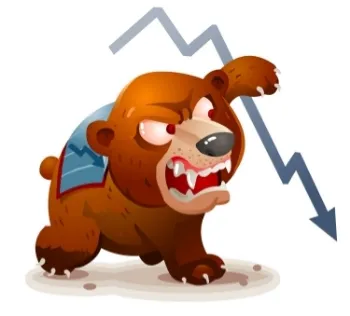
Bear markets are brutal.
- Communities tend to get desperate.
- New users are down bad 80%+.
- Everyone is scrambling to make the pain stop.
- And yet there is nothing to do but wait.
- The best action is inaction.
But that doesn't resonate well.
Just push through the pain? To hell with that! We gotta do something!
And that is when the series of bad ideas begins.
As someone who's already survived a brutal 2-year crypto winter I've seen it all.
Hear me out: we should remove the reward pool.
No, we should freeze rewards and perma-bond them.
Let's make a new token to fix the problem.
Let's do this.
Let's do that.
How about not though?
Every single idea that people come up with in a bear market would only make the problem worse. The damage has already been done, and can not be reversed with a reduction of inflation. The damage was caused by stakeholders not selling during the good times when there was clearly a huge demand to buy. Everyone gets greedy during the bull market, which inevitably leads to an insufferable bear market.
If you want to fix the problem, go back in time and make sure Hive doesn't spike to $3.60. Keep that value outside of the network in case the price crashes and you can buy back in for an x5 gain. That's where we are at right now. Trying to fix the dump after the fact is not an option. Can't fix something that isn't broken. Pump and dumps are the natural order of things unless we actually take steps to stabilize the currency.

How do we stabilize a currency?
It's quite simple really. We need the ability to make number go up and the ability to make number go down. This is the key to creating an elastic money supply that can flux with supply and demand. It's quite obvious, but no one in crypto is actually doing it, which really signals just how greedy and ignorant everyone is.
Everyone understands the mechanics of number-go-up.
Everyone wants number to go up. That's not the problem. The problem is having the self discipline to actually deflate demand and lower the value of the asset when demand is too high and guaranteed to blow up in our faces. Guess which unlikely party actually understands this concept? The Federal Reserve. Interest rates are increasing and the FED is crippling demand, increasing the scarcity of USD in the process.
Here's what everyone misunderstands:
I've already gone through great lengths to explain why crypto and fiat are opposites. Fiat is a debt based system, while crypto is based on true value and ownership of the underlying asset. In the fiat system, even when you hold cash in your pocket, that's not real value; it is still debt. You own the debt. Owning debt is a bit different than owning real value.
So the FED increases rates to reduce demand.
Why? Because it's debt based. Borrowers do not want to pay higher interest rates, thus the demand to take out a loan goes down. The problem with crypto is that people think the same ruleset applies, when it is really the opposite scenario.
Because crypto is not a debt-based system, interest rates are actually called yield (never owed back to anyone), and they are paid directly to the users, who also own the decentralized platform. People don't seem to understand that WE are the central bank. They will parrot the meta and say things like: "Be your own central bank," but they don't actually understand what that means in the context of monetary policy.
If you increase 'interest rates' on crypto, that's just printing more inflation. 99% of people in crypto believe that printing more inflation reduces demand because the currency is being devalued. Debased currency is exactly why crypto exists in the first place, and thus we should not seek to do it. All of these assumptions are provably ridiculous and false.

When a central bank debases a currency, who benefits? Everyone is in agreement that it is the banks and the "too-big-to-fail" zombie corporations and governments that benefit from the debasement of currency. The citizens own the debt, and when that debt is debased, value transfers from the citizens to the institutions in question. Everyone is on board with this logic. No one argues it. These are facts.
When WE are the central bank, would we believe that debasing the currency is bad for us? Does that make sense? It absolutely does not. We are the central bank. We control where the inflation is allocated. It does not make logical sense to say that inflation is bad when you are the one controlling it. No one would argue and try to say that inflation is bad for the Federal Reserve, yet that is the exact argument these same people make for crypto. Make it make sense.

Inflation as an investment.
Again, because crypto is not debt-based, all inflation created is an investment. Bitcoin only invests in one thing: security. 100% of all Bitcoin inflation goes to the miners, and the miners are the only ones preventing double-spend attacks. The niche of Bitcoin is to be as simple and secure as possible, and it does a very good job.
What does Hive invest in?
- 10% to witnesses (security)
- 10% to decentralized @hive.fund (development)
- 15% to HP holders. (largely pointless allocation)
- 65% to reward pool (content creators and 'curators')
- 10+10+15+65 = 100%
- 20% APR (separate from above) to HBD holders in savings.
Aside
You'll notice that I make the claim that the 15% to HP holders is largely pointless. Personally I'd rather see that money allocated elsewhere, like an internal market AMM. The only value of this expenditure is that it kicks out a small amount of yield to accounts that delegate their tokens to another account. So even if you are delegating all your coins to someone else and take a break for a couple years, you can still come back with more coins than when you started. I don't think this benefit is worth having around. It's somewhat of a relic from the past that existed before curation bots were a thing. Hive has better infrastructure now.
Personally I'd rather see that money allocated [elsewhere]...
Even this statement that I just made is somewhat ridiculous. Hive doesn't have a budget. We can pick any inflation schedule we like. We can allocate inflation to anything we like. There are no rules except the ones that we create. We can print money on demand and invest it on anything.
Inflation is the killer dapp.
As stated, inflation/yield/interest within the cryptoverse is an investment. If the money we spend is spent on things that create more value than their cost: we can print money forever, profitably. It's a simple concept that no one in crypto seems to understand. If you make good investments, you make money. If those investments were subsidized using Hive's inflation rate then the network itself owns those investments and profits from them.
There is a reason why Hive allocates inflation to five different things and Bitcoin only allocates inflation to one thing. We believe that the way we allocate inflation has more value than not. Circling back to the main topic at hand: anyone who makes the claim that those inflation allocations are no longer profitable because we are in a bear market? Don't listen to them. That's not a valid argument. It's a fallacy. It's bargaining with reality.
Because lowering yield inside a bear market just makes it worse.
The time to lower yields is during the middle of the BULL market. Once we get to the bear market, it's already too late. During a bear market, we need to be increasing demand through printing more money, not doing the opposite. Yield needs to increase during the bear to incentivize diehards to stack up and get as many tokens as possible. Then yield needs to be slashed as spot-price goes up and we unwind that leverage/demand.
Buy low, sell high
It's a simple concept, that again, people don't seem to understand. When we print more money, we can think of that as going long and "buying" the asset. When we stop printing money, that's a short. It's the same as economic easing and tightening. Print more money to ease, print less money to tighten. Again, such simple concepts that everyone gets backwards for whatever reason.
I blame Bitcoin and the Federal Reserve.
Bitcoin's entire maximalist brand revolves around the 21M hardcap. Bitcoin has had great success, and therefore people want to emulate that success. They get tricked into the narrative that you need a hard cap and deflationary economics to create an asset that does well. That is incorrect. The real value of Bitcoin is that it is simple, unchangeable, reliable, and secure. The hardcap was not a requirement for success, but rather a symptom of these other variables coalescing together.
Bitcoin does not have a hardcap because a hardcap is required for success; Bitcoin has a hardcap because a hardcap is required for security. It is the security of the system that actually has value. If Bitcoin allocated inflation to other things it would be adding needless attack vectors into a platform who's primary attribute is security, which is clearly unacceptable.
This is why all maximalists believe that the hardcap is a recipe for success, when it is really not. It's just a less risky and more conservative strategy, which is perfect for the first crypto ever created. This allows other crypto's to rise up and take more risks within the ecosystem. This is not a competition. Bitcoin helps every other asset to thrive.
Federal Reserve is also to blame.
This is what happens when people conflate [centralized inflation within a debt-based system] to [decentralized inflation within a collateral-based system]. When Fiat central banks increase interest, demand goes down. Crypto central banks increase interest, demand goes up. The relationship between the end-user and a crypto network is the opposite of that of their relationship with fiat/debt. Everything about crypto is the opposite of how the legacy economy works, which is why people so often get it exactly wrong.
Delayed reaction.
Two things happen when interest rates are modified (in both fiat and crypto). Speculation happens instantly, while actual fundamentals take months to play out. The other day I read that it takes 9 months for FED fund rate increases to actually fully circulate through the economy. 9 MONTHS! lol! So basically the economy is going to crash into the mountain because they increased rates so quickly without even waiting to see what happened. Very fuck-around-and-find-out vibes.
Within the context of crypto, the exact same rules apply to interest rates and yields. Speculation happens immediately, but fundamentals aren't going to kick in for nine months. On paper, anyone could double their emission/inflation rate... guess what happens?
What would happen if we increased HBD yield from 20% to 40%? Well, on the first day, nothing would happen on a fundamental level. One day of interest is a proverbial drop in the bucket, and the bill isn't going to come due for months and months (aka compounding interest). But what about the speculation?
All of a sudden HBD holders see that 40% and they are like wow... I need more HBD. So more HBD gets bought instantly on the speculation of 40%. That injects capital into the system, increases the demand for our debt, and pushes the price of Hive up in the short term. Then, a year down the road, the bill comes due, and if we were greedy and left it at 40% for too long and increased our debt ratio in a completely unsustainable way... we are going to be punished for that mistake down the line in a big way.
This is yet another classic example of why we increase emissions during the bear market and we lower them during the bull market, not the other way around. I've made this claim like half a dozen times now, but it's worth mentioning again and again, because most people are not going to believe it until it is actually proven in the field. Books will be written about this topic. Stability matters, and not a single crypto out there is attempting to create an elastic supply. Still early.

Conclusion
As a general rule of thumb, if someone has an idea that stems from the concept that inflation is devaluing the cryptocurrency, it's not a valid idea. If someone thinks they've come up with a good bear market idea to make the number stop going down, they need to show that the idea is also a good one during the bull market as well. If the idea is theoretically good inside of the bear market but not good inside of a bull market, it's not a valid idea. Rather, this is simply fishtail reactionary thinking that will lead to further instability.
During max pain, anyone who tries to say we need to lower inflation needs to be called out. That's exactly the opposite of what we should actually be doing. Lowering inflation on a non debt-based system lowers demand, and will lower price as well. Overcorrections do not lead to a balanced ecosystem. The best course of action when you lose control of a car is not to turn in the opposite direction, but rather to just keep driving straight forward. In fact, professional drivers will turn into the direction they are being pushed to regain control. Emphasis on 'professional', because if you try to employ pro-moves as a novice you may end up in a full head-on collision. This metaphor applies to crypto and economic policy quite often as well.
So what's the best course of action for Hive in a bear market? Do nothing. Just sit there and take it. There is nothing to do but wait out the storm. Reactionary policy is never going to work when it takes 9 months for fundamentals to kick in. We have to see the storm coming 9 months in advance and preemptively take steps to mitigate it. Easier said than done, and that time has already come and gone for the crypto market, unfortunately.
Posted Using LeoFinance Beta
Return from Bear Market Ideas & The Inflation Debacle to edicted's Web3 Blog
